Resistor & Types of Resistors – Fixed, Variable, Linear & Non-Linear
Different Types of Resistors – Fixed, Variable, Linear and Non-Linear Resistors & Applications
What is Electrical Resistance?
The property of a substance which opposes the flow of electric current (or electricity) through it is called Resistance OR Resistance is the ability of a circuit which opposes current.
Mica, Glass, Rubber, Wood etc. are the examples of resistive materials. The unit of resistance is OHM (Ω) where 1Ω = 1V/1A. which is derived from the basic electrical Ohm’s law = V = IR.
Other definitions of Ohm “Ω” are as follows;
If there is a potential difference of 1 volt between two ends of the conductor and the flowing current through it is 1 Ampere, then the resistance of that conductor would be 1 Ohm (Ω). OR
If 1 ampere of current is flowing through a resistance, and 1 joule per second (1Watt) energy (in the form of heat) is generated, then the measurement of that resistance is 1 Ω.
Ohm is the measurement quantity of resistance, which produces one joule of energy (in the form of heat) in one second, when one ampere of current is flowing through it.
The reciprocal of the resistance is called conductance.
What is an Eclectic Resistor?
A resistor is a component or device designed to have a known value of resistance. OR,
Those components and devices which are specially designed to have a certain amount of resistance and used to oppose or limit the electric current flowing through it are called resistors.
Good to know: Resistance of a resistor depends on their length (l), resistivity (ρ) and its cross sectional area (a) which is also known as laws of resistance … R = ρ (l/a).
IEEE & IEC symbols of Resistors
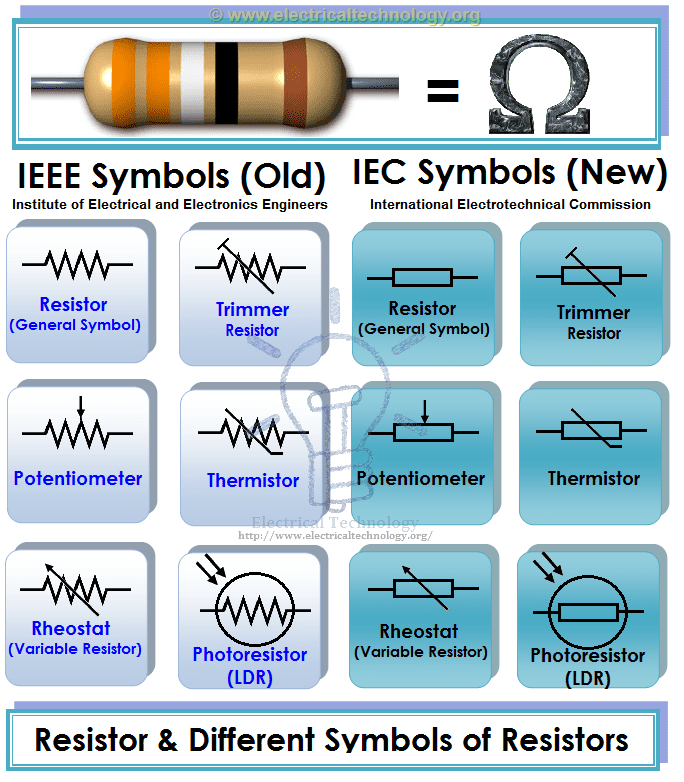
Types of Resistors:
Resistors are available in different size, Shapes and materials. We will discuss all possible resistor types one by one in detail with pro and cons and application as follow.
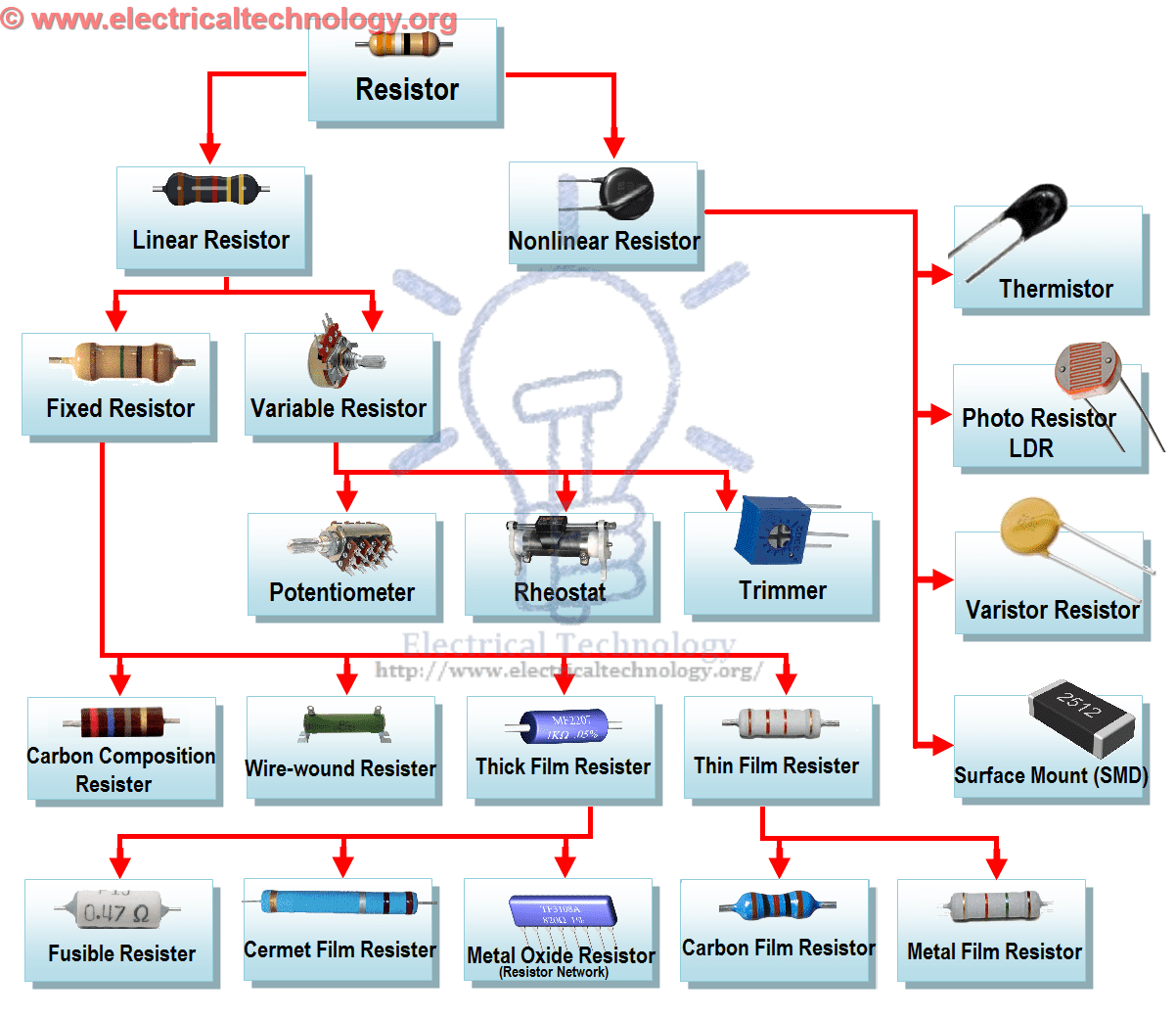
There are two basic types of resistors.
- Linear Resistors
- Non Linear Resistors
Linear Resistors:
Those resistors, which values change with the applied voltage and temperature, are called linear resistors. In other words, a resistor, which current value is directly proportional to the applied voltage is known as linear resistors.
Generally, there are two types of resistors which have linear properties.
- Fixed Resistors
- Variable Resistors
Fixed Resistors
As the name tells everything, fixed resistor is a resistor which has a specific value and we can’t change the value of fixed resistors.
Types of Fixed resistors.
- Carbon Composition Resistors
- Wire Wound Resistors
- Thin Film Resistors
- Thick Film Resistors
Carbon Composition Resistors
A typical fixed resistor is made from the mixture of granulated or powdered carbon or graphite, insulation filler, or a resin binder. The ratio of the insulation material determines the actual resistance of the resistor. The insulating powder (binder) made in the shape of rods and there are two metal caps on the both ends of the rod.
There are two conductor wires on the both ends of the resistor for easy connectivity in the circuit via soldering. A plastic coat covers the rods with different color codes (printed) which denote the resistance value. They are available in 1 ohm to 25 mega ohms and in power rating from ¼ watt to up to 5 Watts.
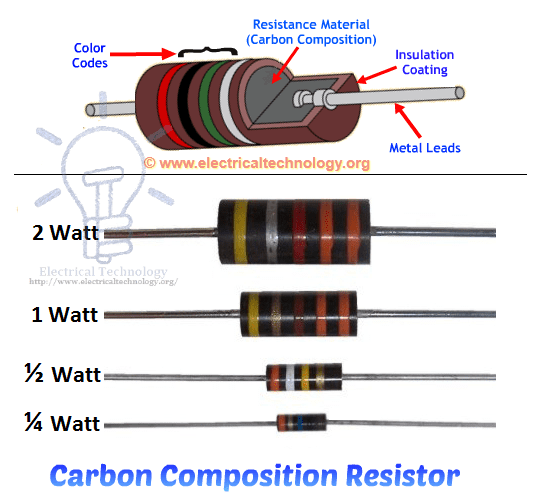
Characteristic of Fixed Resistors
Generally, they are very cheap and small in size, hence, occupy less space. They are reliable and available in different ohmic and power ratings. Also, fixed resistor can be easily connected to the circuit and withstand for more voltage.
In other hand, they are less stable means their temperature coefficient is very high. Also, they make a slight noise as compared to other types of resistors.
Related Posts:
- Capacitor and Types Of Capacitors – Fixed, Variable, Polar & Non-Polar
- Types of Inductors and Their Applications
Wire Wound Resistors
Wire wound resistor is made from the insulating core or rod by wrapping around a resistive wire. The resistance wire is generally Tungsten, manganin, Nichrome or nickel or nickel chromium alloy and the insulating core is made of porcelain, Bakelite, press bond paper or ceramic clay material.
The manganin wire wound resistors are very costly and used with the sensitive test equipment e.g. Wheatstone bridge, etc. They are available in the range of 2 watts up to 100 watt power rating or more. The ohmic value of these types of resistors is 1 ohm up to 200k ohms or more and can be operated safely up to 350°C.
in addition, the power rating of a high power wire wound resistor is 500 Watts and the available resistance value of these resistors are is 0.1 ohm – 100k Ohms.
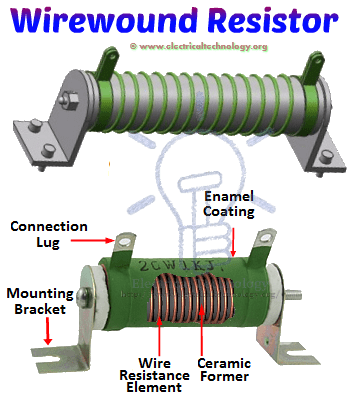
Advantages and Disadvantage of Wire wound Resistors
Wire wound resistors make lower noise than carbon composition resistors. Their performance is well in overload conditions. They are reliable and flexible and can be used with DC and Audio frequency range. Disadvantage of wire wound resistor is that they are costly and can’t be used in high frequency equipment.
- Related Post: Types of SSR Relays – Construction & Operation
Application of Wire Wound Resistors
Wire wound resistors used where high sensitivity, accurate measurement and balanced current control is required, e.g. as a shunt with ampere meter. Moreover, Wire wound resistors are generally used in high power rating devices and equipment, Testing and measuring devices, industries, and control equipment.
Thin Film Resistors
Basically, all thin film resistors are made of from high grid ceramic rod and a resistive material. A very thin conducting material layer overlaid on insulating rod, plate or tube which is made from high quality ceramic material or glass. There are two further types of thin film resistors.
- Carbon Film Resistors
- Metal Film Resistors
Carbon Film Resistors
Carbon Film resistors contains on an insulating material rod or core made of high grade ceramic material which is called the substrate. A very thin resistive carbon layer or film overlaid around the rod. These kinds of resistors are widely used in electronic circuits because of negligible noise and wide operating range and the stability as compared to solid carbon resistors.
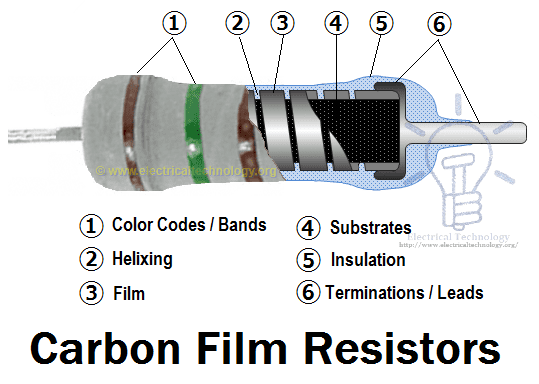
Metal Film Resistors
Metal film resistors are same in construction like Carbon film resistors, but the main difference is that there is metal (or a mixture of the metal oxides, Nickel Chromium or mixture of metals and glass which is called metal glaze which is used as resistive film) instead of carbon. Metal film resistors are very tiny, cheap and reliable in operation. Their temperature coefficient is very low (±2 ppm/°C) and used where stability and low noise level is important.
- Related Post: Types of Solar Panel and Which one is the best PV Panel
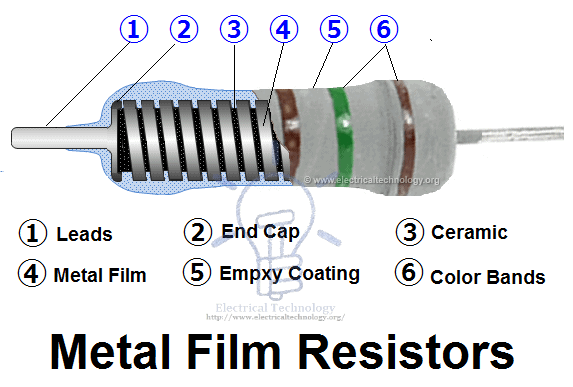
Thick Film Resistors
The production method of Thick film resistors is same like thin film resistors, but the difference is that there is a thick film instead of a thin film or layer of resistive material around. That’s why it is called Thick film resistors. There are two additional types of thick film resistors.
- Metal Oxide Resistors
- Cermet Film Resistors
- Fusible Resistors
Metal Oxide Resistors
By oxidizing a thick film of Tin Chloride on a heated glass rod (substrate) is the simple method to make a Metal oxide Resistor. These resistors are available in a wide range of resistance with high temperature stability. In addition, the level of operating noise is very low and can be used at high voltages.
Cermet Oxide Resistors (Network Resistors)
In the cermet oxide resistors, the internal area contains on ceramic insulation materials. And then a carbon or metal alloy film or layer wrapped around the resistor and then fix it in a ceramic metal (which is known as Cermet). They are made in the square or rectangular shape and leads and pins are under the resistors for easy installation in printed circuit boards. They provide a stable operation in high temperature because their values do not change with change in temperature.

Fusible Resistors
These kinds of resistors are same like a wire wound resistor. When a circuit power rating increased than the specified value, then this resistor is fused, i.e. it breaks or open the circuit. That’s why it is called Fusible resistors. Fusible restores perform double jobs means they limit the current as well as it can be used as a fuse.
They used widely in TV Sets, Amplifiers, and other expensive electronic circuits. Generally, the ohmic value of fusible resistors is less than 10 Ohms.
Variable Resistors
As the name indicates, those resistors which values can be changed through a dial, knob, and screw or manually by a proper method. In these types of resistors, there is a sliding arm, which is connected to the shaft and the value of resistance can be changed by rotating the arm. They are used in the radio receiver for volume control and tone control resistance.
- Related Post: Types of Fuses
Following are the further types of Variable Resistors
- Potentiometers
- Rheostats
- Trimmers
Potentiometers
Potentiometer is a three terminal device which is used for controlling the level of voltage in the circuit. The resistance between two external terminals is constant while the third terminal is connected with moving contact (Wiper) which is variable. The value of resistance can be changed by rotating the wiper which is connected to the control shaft.
- Related Post: Types of Transformers and Their Applications
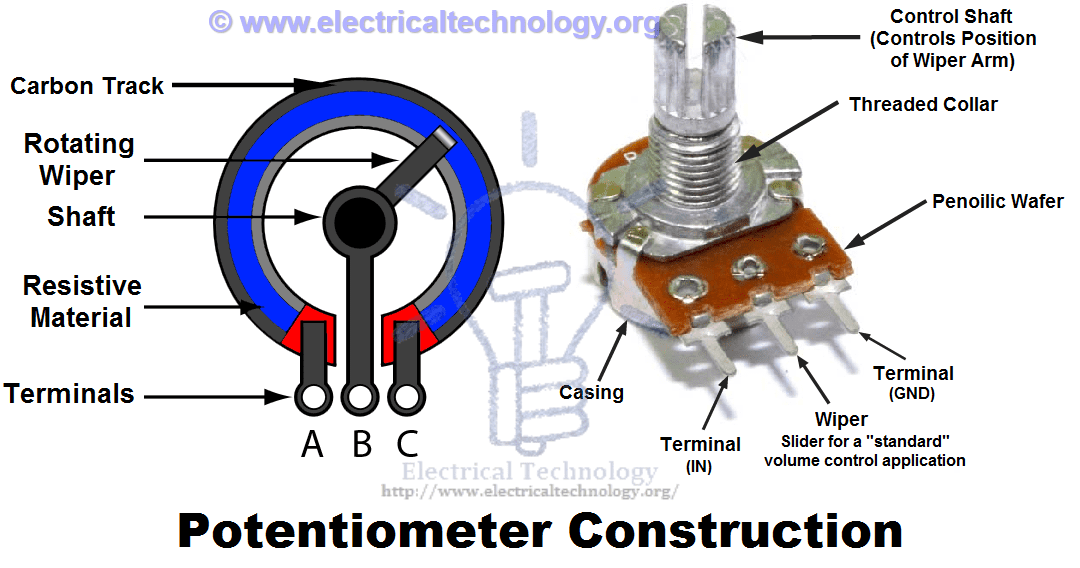
This way, Potentiometers can be used as a voltage divider and these resistors are called variable composition resistors. They are available up to 10 Mega Ohms.
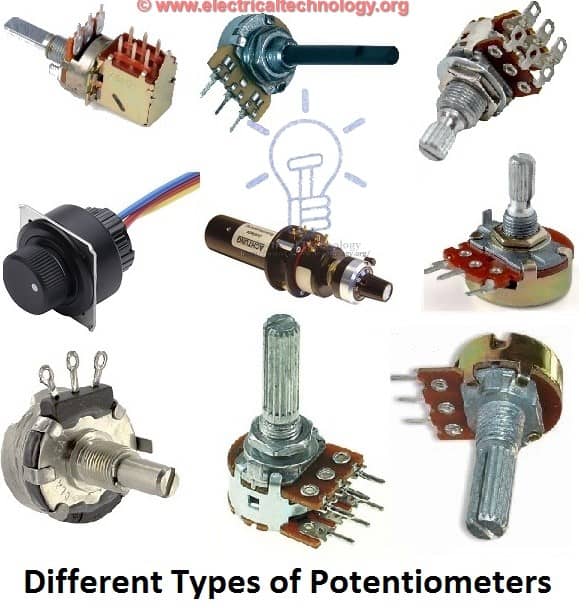
Rheostats
Rheostats are a two or three terminal device which is used for the current limiting purpose by hand or manual operation. Rheostats are also known as tapped resistors or variable wire wound resistors.

To make a rheostats, they wire wind the Nichrome resistance around a ceramic core and then assembled in a protective shell. A metal band is wrapped around the resistor element and it can be used as a Potentiometer or Rheostats (See the below note for difference between Rheostat and Potentiometer).

Variable wire wound resistors are available in the range of 1 ohm up to 150 Ohms. The available power rating of these resistors is 3 to 200 Watts. While the most used Rheostats according to power rating is between 5 to 50 Watts.
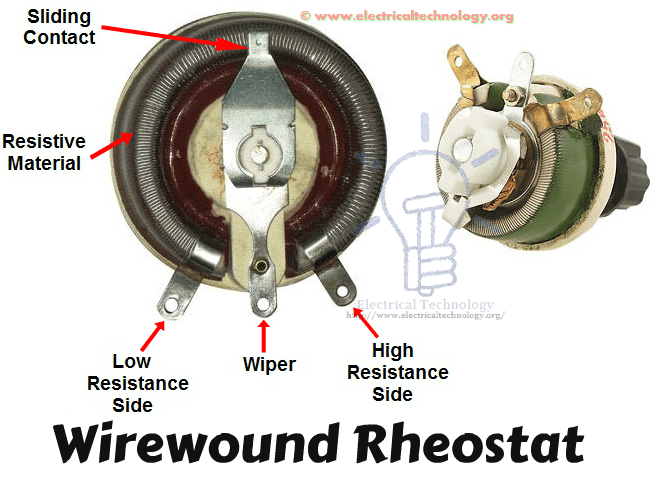
Good to Know:
What is the main Difference between Potentiometer and Rheostats?
Basically, there is no difference between Potentiometer and Rheostat. Both are variable resistors. The main difference is the use and circuit operation, i.e. for which purpose we use that variable resistor?
For example, if we connect a circuit between resistor element terminals (where one terminal is a general end of the resistor element while the other one is sliding contact or wiper) as a variable resistor for controlling the circuit current, then it is Rheostats.
On the other hand, if we do the same as mentioned above for controlling the level of voltage, then this variable resistor would be called a potentiometer. That’s it.
Trimmers
There is an additional screw with Potentiometer or variable resistors for better efficiency and operation and they are known as Trimmers. The value of resistance can be changed by changing the position of screw to rotate by a small screwdriver.
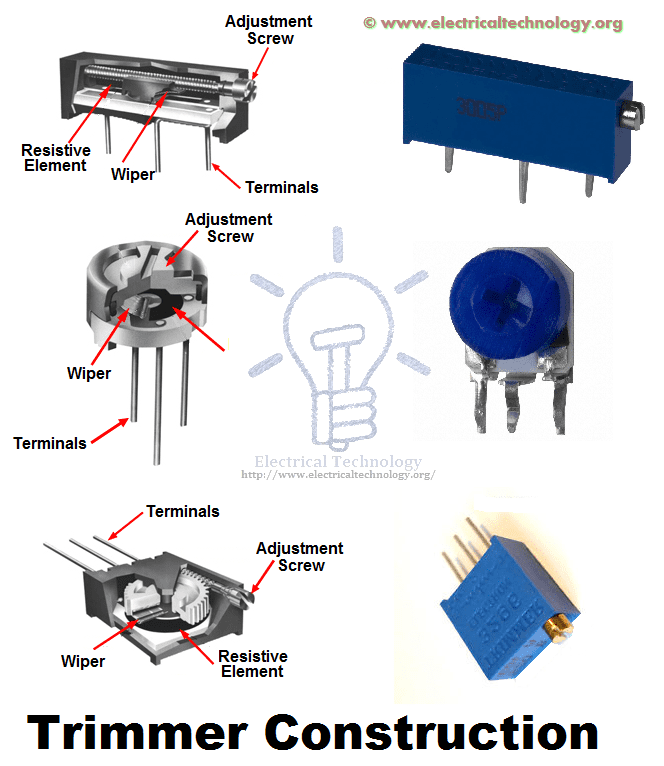
They are made from carbon composition, carbon film, cermet and wire materials and available in the range of 50 Ohms up to 5 mega ohms. The power rating of Trimmers potentiometers are from 1/3 to ¾ Watts.
Related Posts:
Non Linear Resistors
We know that, nonlinear resistors are those resistors, where the current flowing through it does not change according to Ohm’s Law but, changes with change in temperature or applied voltage.
In addition, if the flowing current through a resistor changes with change in body temperature, then these kinds of resistors are called Thermistors. If the flowing current through a resistor change with the applied voltages, then it is called a Varistors or VDR (Voltage Dependent Resistors).
Following are the additional types of Non Linear Resistors.
- Thermistors
- Varisters (VDR)
- Photo Resistor or Photo Conductive Cell or LDR
Thermistors
Thermistors is a two terminal device which is very sensitive to temperature. In other words, Thermistors is a type of variable resistor which notices the change in temperature. Thermistors are made from the cobalt, Nickel, Strontium and the metal oxides of Manganese. The Resistance of a Thermistor is inversely proportional to the temperature, i.e. resistance increases when temperature decrease and vice versa.
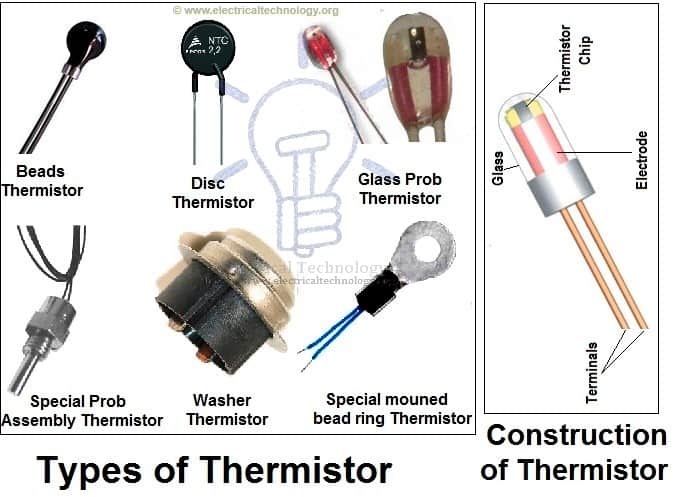
It means, Thermistors has a negative temperature coefficient (NTC) but there is also a PTC (Positive Temperature Coefficient) which a made from pid Barium Titanate semiconductor materials and their resistance increases when increases in temperature.
Varisters (VDR)
Varisters are voltage dependent Resistors (VDR) which is used to eliminate the high voltage transients. In other words, a special type of variable resistors used to protect circuits from destructive voltage spikes is called varisters.
When voltage increases (due to lighting or line faults) across a connected sensitive device or system, then it reduces the level of voltage to a secure level i.e. it changes the level of voltages.
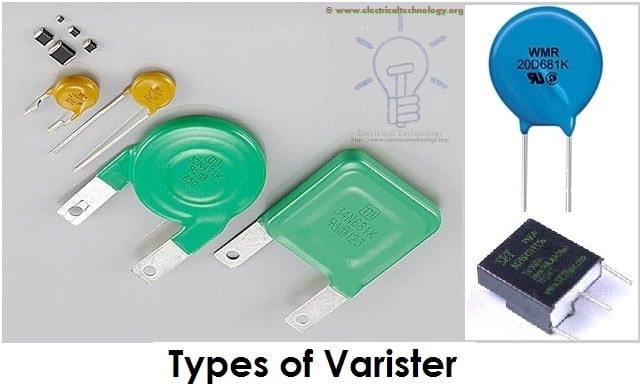
Photo Resistor or Photo Conductive Cell or LDR (Light Dependent Resistors)
Photo Resistor or LDR (Light Dependent Resistors) is a resistor which terminal value of resistance changes with light intensity. In other words, those resistors, which resistance values changes with the falling light on their surface is called Photo Resistor or Photo Conductive Cell or LDR (Light Dependent Resistor). The material which is used to make these kinds of resistors is called photo conductors, e.g. cadmium sulfide, lead sulfide etc.
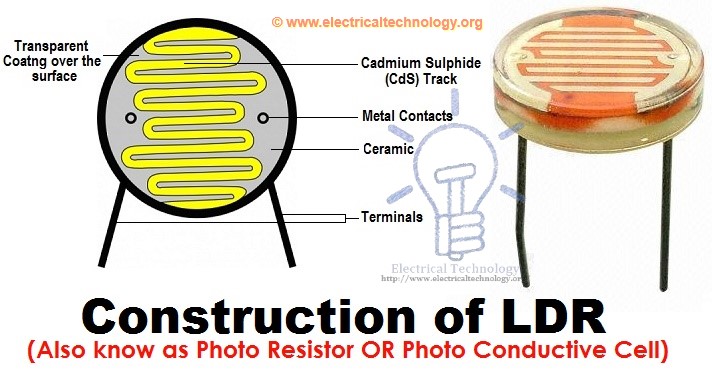
When light falls on the photoconductive cells (LDR or Photo resistor), then there is an increase in the free carriers (electron hole pairs) due to light energy, which reduce the resistance of semiconductor material (i.e. the quantity of light energy is inversely proportional to the semiconductor material). It means photo resistors have a negative temperature coefficient.

SMD (Surface Mount Technology) Resistors
You can read mor details about special resistors i.e. SMD Resistor with color coding methods which we have already discussed before.
Application and Uses of Photo Resistors/Photo Conductive Cells or LDR
These types of resistors are used in burglar alarm, Door Openers, Flame detectors, Smock detectors, light meters, light activated relay control circuits, industrial, and commercial automatic street light control and photographic devices and equipment.
Related Post:
- Different Types of Sensors with Applications
- Types of Resistive Sensors – Transducer, Potentiometer & Strain Gauge
Application of Resistors
Practically, both types of resistors (Fixed and Variable) are generally used for the following purposes.
Resistors are used:
- For Current control and limiting
- To change electrical energy in the form of heat energy
- As a shunt in Ampere meters
- As a multiplier in a Voltmeter
- To control temperature
- To control voltage or Drop
- For protection purposes, e.g. Fusible Resistors
- In laboratories
- In home electrical appliances like heater, iron, immersion rod etc.
- Widely used in the electronics industries
Good to Know: The characteristic of different types of resistors are same on both AC and DC but there is a difference between AC & DC Resistance.
Related Posts:
- Resistor Color Code Calculator – 3, 4, 5 & 6 Band Resistors Calculation
- Required Value of Resistor for LED’s Circuit Calculator
- How to find The value of Burnt Resistor (Three handy Methods)
- Standard Resistor Closest Value Calculator
- Why is Zero Ohm Resistor Used? 0-Ω Resistor Applications
- What is a Thermistor? Types of Thermistors and Applications


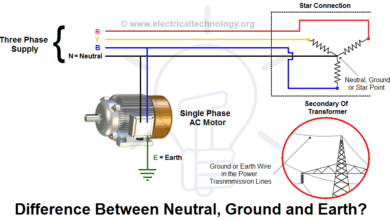



Very comprehensive! Thank you very much!
You appreciation motivate us for good work. Thank You.
nice sir
can i be getting this in my e-mail
Yes Sure… Just put your email address in the top lift corner email subscription box… and you will get each of post like this in your email.
please send it on my email email is aqilshah16@gmail.com
nice things
complete knowledge about any equipments
Dear Sirs,
Thank you very much for your resistor presentation . I would like to download for this chapter for my own study and to teach my marine students. Could you please send me this basic concept chapters.
I will appreciate for it.
Good.. Very Good
very excellent information about resistor.thank you so much sir for this kind of information
thanks for your nice guide.
Can I get pdf or word file for this Resistance Info?
Thank you so much for your presentation.
good work
Can I get pdf or word file for this Resistance Info?
I am really thankful to the blog owner for helping us by giving valuable study materials.
Thank you for this presentation, but there is a note about SMD resistor, whay you classed with nonlinear resistor
it’s an other technologie named SMD and the others are the old technologie named TH or THT
and in SMD technologie there is a deferent type of resistor like thermistor or fixed resistor
Thank you
very well explained
I am an electrician with 59 years experience both in the UK and Indonesia and I thank you for such a wonderful coverage of this subject. I will be asking for suggestions later for a potentiometer which I need to replace the remote control of a Maspion 3-in-one cool air fan. I wish to control it with a variable from very low to standard high speed operation and to incorporate the potent within the front housing – I do not have a wiring diagram so am using pos and neg only – I do not think the armature is load protected.
Please add me to your mailing list/forum
Basic Electrinics
Hai
Am kindly asking what resistor to use on the linear heat detector.kindly help on this, the linear is rated 68 degrees.
Thank you for the detailed article on resistors.